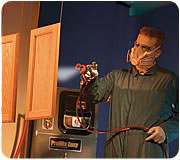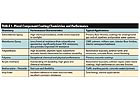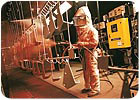The 2K Advantage

Electronic metering devices for plural component systems have become more sophisticated and more robust. Photo courtesy of Graco, Inc.
Most organic coatings used today involve a chemical reaction to cure or set the finish. Some require elevated temperatures or ultraviolet (UV) radiation to accelerate the curing and therefore manage the finishing process time. Plural component technology, in some cases referred to as 2K (from the German 2-komponent), employs an alternate technique. Two or more very reactive components are mixed shortly before or as the coating is applied. The components are so reactive that the mixture usually does not need additional energy (heat) to achieve complete cure.
Compared to conventional solventborne coatings, the advantages of this technique are numerous and include:
- Low energy costs
- Shorter process time
- High quality chemistries available
- Lower volatile organic compound (VOC) content
The simplest plural component technology requires manual measuring of the constituents and hand mixing. The operator has to carefully estimate how much coating material is needed and how much can be applied before the mixture sets up in the container (commonly referred to as “pot life”). Environmental conditions and the homogeneity of the blend influence the cure rate of the mixture. Operator expertise and consistency are also critical factors to the performance of the ultimate finish. In addition, cleanup can be difficult. As the mixture reacts chemically, it becomes more viscous and more chemically resistant. Large volumes of strong solvents are sometimes needed to clean spray guns, mixing and delivery equipment. This can create VOC emission and waste disposal issues.
In recent years, equipment companies have developed apparatus that automatically meters and delivers the multiple components. The highly reactive ingredients are precisely and consistently blended immediately prior to dispatch from the application gun. This technology eliminates many shortcomings of a manually mixed system. Operator mixing errors are minimized, cleanup is streamlined and less material is wasted.
Where Are 2K Systems Used?
Plural component coatings technology spans a variety of industries and applications, from something as basic as a floor coating to the sophistication of aerospace applications (see sidebar: Common Applications of Plural Component Systems). Most 2K coatings have end uses that demand a high level of chemical resistance. A natural market for plural component paints is the arena of field-applied coatings. This technology is a great option for monumental structures that are nearly impossible to heat.
Coating Chemistries and Performance
A surprisingly large array of chemistries is common to plural component technology. Most prominent are epoxies for primers and polyurethanes for weather-resistant topcoats; however, any highly reactive chemistry can be adapted to fit this type of application technique, including polyurea, acrylic urethane, methacrylate/peroxide and vinyl ester (see Table 1).The epoxies provide highly chemical resistant finishes that inherently chalk when exposed to sunlight. They find use as primers, floor finishes and coatings for underground gas and oil pipelines. Potable water systems can also be coated with epoxies. Lately waterborne versions of epoxy chemistry have emerged. These products are less chemically resistant but significantly reduce VOC emissions. Performance of waterborne epoxies is slightly less than their solventborne counterparts; however, these recently developed aliphatic waterborne chemistries offer improved UV resistance, making them useful in many exterior applications.
Polyurethanes can be aromatic or aliphatic and typically require a catalyst in addition to two reactive components. Polyurethanes can also be driven by a moisture cure reaction. These materials are typically used as exterior durable topcoats or single coat finishes. Aliphatic types greatly outperform aromatic-based chemistries for outdoor durability. Polyurethanes find use where high performance is required, such as automotive topcoats, exterior tanks and structures, concrete floors and wood finishing.
Polyureas provide exceptional performance both chemically and physically. They are based on aromatic chemistry similar in structure to polyurethanes. Their unique chemistry allows for very fast cure times, which avoids the cure problems some urethanes encounter with humid and low temperature conditions. Polyureas are typically used as primers and concrete coatings.
Acrylic urethanes offer outstanding UV durability, high gloss and chemical resistance. These higher priced systems are used as automotive topcoats, collision repair, water tower coatings and high performance concrete finishes.
Methacrylate plural component coatings use free radical cure chemistry accelerated by a peroxide initiator. These fast cure flexible coatings find use as traffic marking paints and concrete sealer/primers.
Vinyl ester two component paints provide excellent adhesion to steel and concrete. Because of their outstanding corrosion resistance they are often used as tank linings and for marine applications.

Some of the latest equipment advances include more precise ratio monitoring and more efficient flushing technology. Photo courtesy of Graco, Inc.
New Developments and Challenges
Plural component technology is the answer for many industrial finishers’ needs; however, challenges still remain. On the materials side, the epoxy amine systems pose somewhat of a toxicity issue, so formulators have developed non-amine based products. These newer products might not provide the same chemical resistance as the amine types, but they offer a vast improvement in outdoor durability. Don Cassil, the director of design engineering for Sherwin-Williams, reports that a push is being made in the industry toward lower VOCs and non-isocyanate technology. A number of waterborne and water reducible technologies have recently emerged and are gaining a foothold in many markets, especially for military applications such chemical agent resistant coatings (CARCs).Proportioning technology also continues to improve. Electronic metering systems have become more sophisticated and more robust and are now able to handle highly filled materials without premature wear. Material flow is easier to manage and monitor. Reduction of waste is also a priority. Cassil says that equipment makers are developing devices that will eliminate the last little bit of waste between the mixing block and the gun tip.

User interfaces have significantly improved, allowing better monitoring of material flow and proportioning. They also have routines that allow for self-diagnosis of material delivery issues.
Probably the biggest equipment challenge looming on the horizon is the high capital cost associated with the more sophisticated units. Most equipment is manufactured either in the U.S. or Western Europe. A basic entry-level system can cost as little as $6,000, whereas a complex automated plural component finishing line commands upwards of $500,000. A strong potential for offshore manufacture exists, in spite of the latest technology being protected by recent patents. The biggest deterrent to this development is the question of quality and local service.
Plural component finishing technology offers high performance, fast cure at ambient and below temperatures, and a vast array of chemistries to meet virtually any coating specification. Expect its share of the industrial coatings market to remain stable and to grow as the economy prospers.
Links
Looking for a reprint of this article?
From high-res PDFs to custom plaques, order your copy today!




